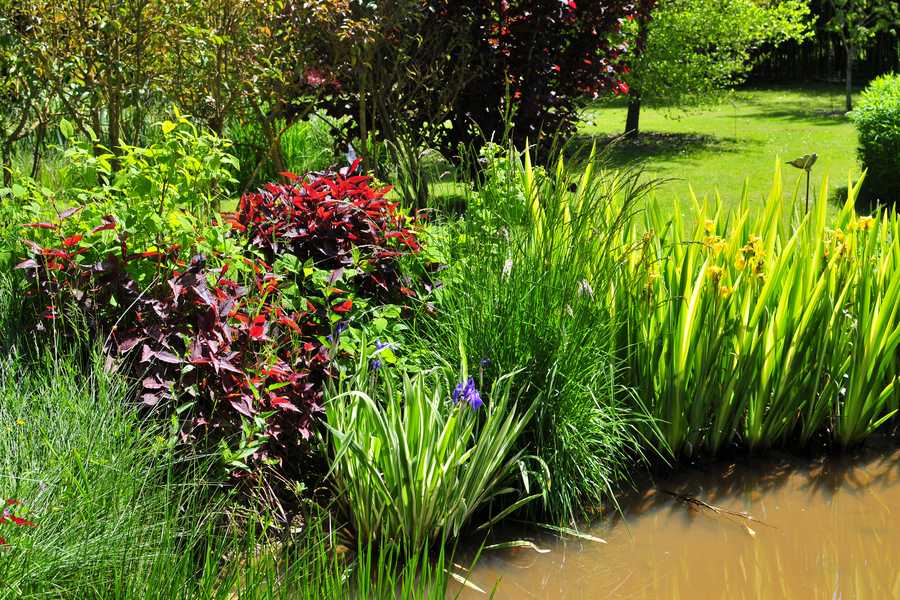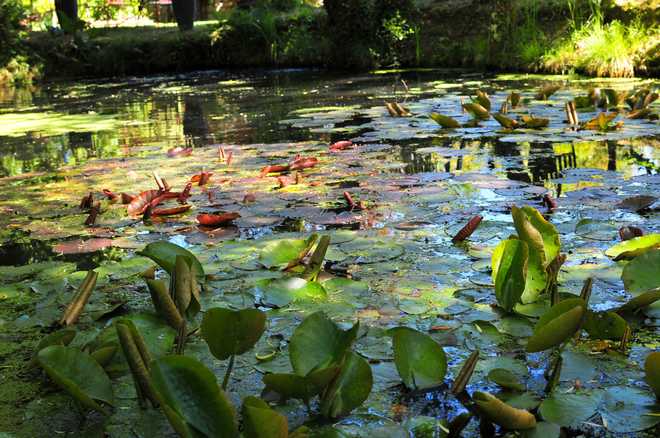
To decorate a basin or a small pond with hardy aquatic plants, the most important thing is to respect their requirements, in particular their planting depth.
Plants for an outdoor pond are classified according to 4 zones:
- Bank or shore plants need soil that remains cool in summer, but never soggy or submerged in winter.
- Semi –aquatic plants appreciate a shallow depth of water (10 cm maximum) but tolerate partial drying out.
- The majority of aquatic plants live under a water depth of between 20 and 40 cm. This is why preformed pools have stepped landings.
- Water lilies are a special case: these floating aquatic plants settle in the area of the pond with the greatest depth.
Which plants to choose for the banks?
In summer, these semi-aquatic perennials appreciate the coolness of the ground overhanging a garden pond or a stream. But they can’t stand having their feet in the water during the winter.
These needs must be respected and the following plants must be planted directly on the banks, 20 to 50 cm above the water level.
- Primula japonica, the Japanese (Japanese) primrose
- Persicaria amplexicaulis, the peach knotweed
- Lythrum salicaria, loosestrife
- Gunnera manicata, the Gunnera of Brazil
- Iris kaempferi, the Japanese iris
- Astilbe x arendsii , l’Astilbe
- Salvia uliginosa, the sage of the Marais
Shallow water plants
The plants in this area are of two types:
First of all, there is a list of semi-aquatic plants that accept being submerged by a few centimeters (3 to 5 cm, no more). These are for example:
- Iris laevigata, the shore iris
- Calla palustris, the Arum of Swamps
- Butomus umbellatus, the flowering rush
- Caltha palustris, the water marigold or marsh marigold
- Alternate-leaved Nutsedge (Cyperus alternifolius) and Papyrus
A second group of pond plants do well when planted about 10 cm below water level . It is :
- Menyanthes trifoliata, water clover
- Typha angustifolia, the small cattail
- Sagittaria sagittifolia, the water arrow.
Finally, the Iris pseudacorus, or marsh iris, is less demanding. It accepts being planted in 20 cm of water just as it supports being installed higher on the banks, as long as the earth does not dry out completely in summer.

Deep pond plants
Given their requirements, it is best to plant the aquatic plants of this group in a suitable substrate by filling baskets.
You can thus place the youngest plants near the surface of the water and immerse them deeper as they grow, until they reach their comfort zone between 20 and 40 cm as adults. of depth r.
- Hydrocharis bite-frog la morène
- Myriophyllum verticillatum, Watermilfoil
- Aponogeton distachyos, water vanilla
- Pontederia cordata, the heart-leaved pontederia
- Elodea canadensis, Waterweed of Canada
- Nelumbo nucifera, the lotus
- Potamogeton crispus, the frizzy or tense pondweed.
- Pistia stratiotes, water lettuce
The water lily, a plant for the bottom of the pond
Water Lilies are both floating and deep water plants . The various water lilies indeed spread their leaves on the surface of the water but they need to install their roots at the bottom of the basin. The depth of water required depends on the varieties. It is therefore necessary to inquire at the time of purchase: the ideal depth is always indicated by the seller or on the label that accompanies the plant.
This great depth of water is also essential to protect them from freezing in winter. The fish in the pond also take refuge in their roots in winter and when spawning.
